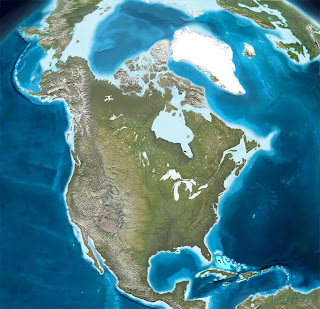NORTH AMERICA
Area: 9,355,000 square miles
Climate(s): arctic, subarctic, tundra, marine, mountain, Mediterranean, temperate, highlands, interior plains, coastal plain, tropical, semiarid and arid.
Population: 528,720,588 [2008 est.]
Density: 22.9/km2 (59.3/sq mi)
Main languages English, French, Spanish
Principal Religions: Roman Catholics, Protestants, Islam, Eastern Orthodoxy
Literacy: 89.6%
Largest cities: Mexico city, New York city, Los Angeles, Chicago, Santo Domingo, Havana, Guadalajara, Houston, Philadelphia, Nezahualcoyotle, San Diego, Monterrey, Detroit, Montreal, Pueblo, Dallas, Phoenix, San Antonio.
Imports: 53.8 percent
Exports: 46.2 percent
History
North America, the land mass the houses "The land of the free and the home of the brave"; a.k.a The United States of America, Canada, all the way down to Mexico. The rest of the world has only known about North America for a short time (in comparison to the other continents). However, that does not mean that it was uninhabited. North America was inhabited for thousands of years before Europeans discovered this great landmass. Thousands of years ago, a land bridge connected Asia and the United States. Asian nomads worked their way across the land bridge and stayed in this new land. The land bridge gradually disappeared and the Asians separated into different tribes, spreading across the whole stretch of the United States. They grew used to life on North America, and expanded quickly. So, even though people of European descent have lived on North America for hundreds of years, North America was really discovered by the natives.
Columbus sailed the ocean blue in 1492. That is a rhyme that many children use to remember the year of Columbas' journey to the New World. Columbus was searching for a quicker route to Asia, but just happened to hit North America. He thought that he had landed in India, however, so he called the natives Indians. Columbus' discovery opened up North America for colonization and further exploration. However it was said the Vikings accidentally discovered it first.
More and more people came to North America to settle and start a life of their own. They would set up colonies, or places on another part of the world controlled by a country far away. Most of the colonies were controlled by Britain, although France, Portugal, and Spain also had colonies there. At that time Britain controlled over half the world. The British taxed their colonies heavily and cruelly gave them no representation in the British Parliament. Soon the colonies rebelled and claimed independence. That was the start of The United States of America. Soon after, Canada and Mexico also claimed there independance. That marked the beginning of a free and independant North America.
Slowly this "New World" developed into one of the most economicly and technologicly advanced continents in the world. In fact the United States of America's power and technology greatly aided the British in World War one and two, although most countries in North America try to stay neutral in wars. Today North America is full of resources and economic wealth. Today North America is home to twenty two indepentent countries.
Technology and Industry
North America is blossoming with technology and economic wealth. There is every thing from stealth bombers to computers to video games. There is a foreign trade of over one trillion dollars in North America. The United States of America is especially wealthy (however at the time we are in a bad recession). They are also one of the most technologicly advanced countries in the world. A good example of American technology is the plentiful computer equipment sold there. The worlds largest computer company in the world Microsoft has their headquarters there. There is also their space program, NASA. They were the first to land a man on the moon. Also in the United States is one of the worlds most powerful militaries. That United States military played a key role in the second World War, the Vietnam war and the Gulf war. United States neighboring countries (Mexico and Canada) unlike America have medium economies and, unfortunately the small countries around Mexico in central America are fairly poor. North America is a very diverse culture. People tend to call it the "melting pot". There are examples of every way of life, from the most technologicly advanced countries to the small poor ones.
Climate, Geography, Terrian and Wildlife
North America also has a very diverse climate. It ranges from the arctic cold of alaska and Canada to the tropical heat of central America. The terrain is also very diverse. There's everything from plains to mountains, desterts to tropical forests, frozen artic lands to deserts. There are also many large cities such as Mexico city, New York city, San Francisco, and Chicago. North America is also home the the second and third largest countries in the world, Canada and the United Sates of America. Also located in the United States of America is the hottest place on North America, Death Vally, California.


No comments:
Post a Comment